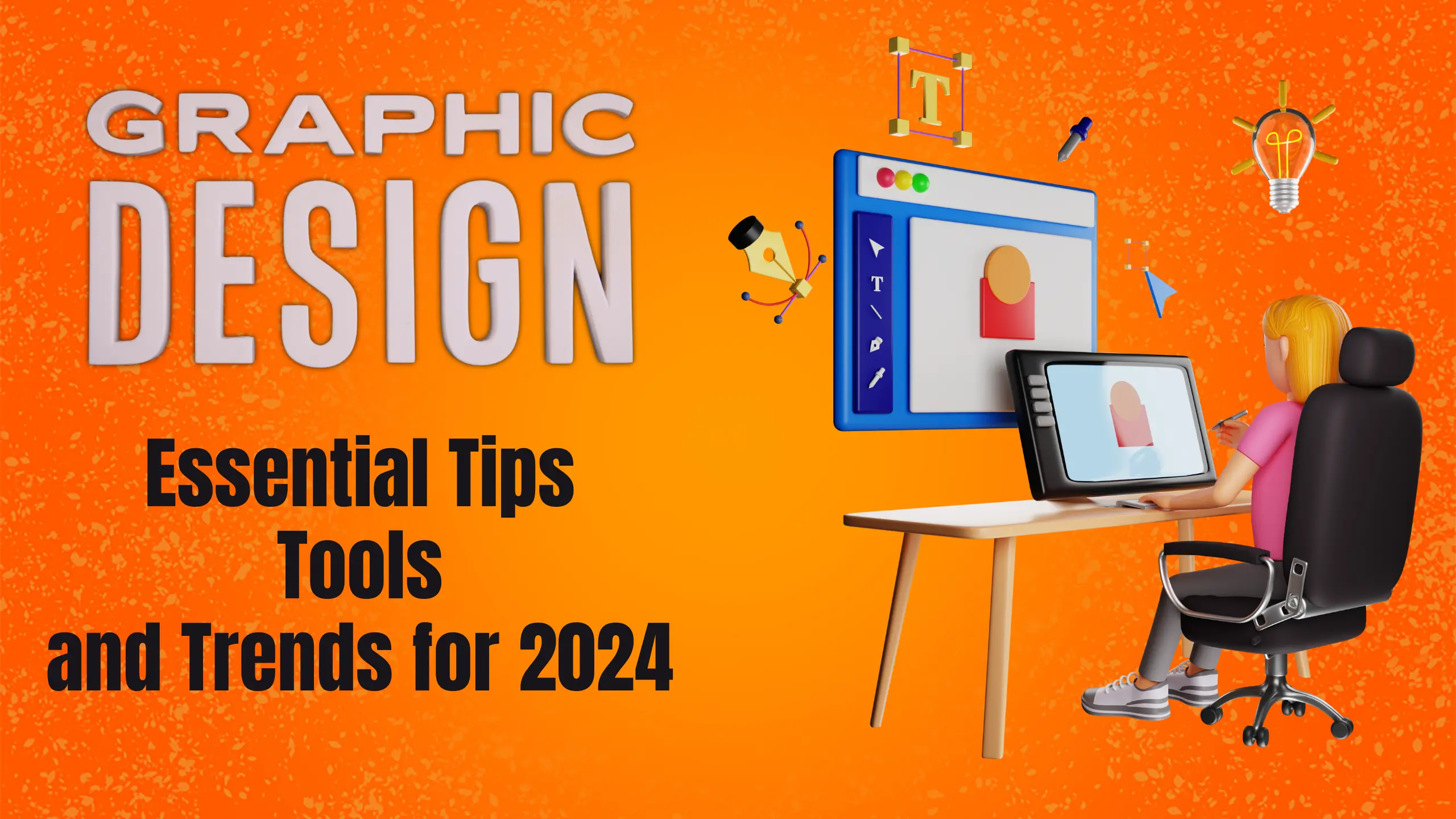Graphic design is not only about making excellent images; it is about sharing the message and attracting the audience to the given cause or product. For a professional as well as for an inexperienced person, it is always significant to put an emphasis upon the factors connected with the tendencies, the tools, and the tips in the field of designer that is always in the process of development. So in this article, it will be divided into 3 sections, to include, Understanding of graphic Design, Essential Tools of 2024 and Trends to Look out for.
What is Graphic Design?
Graphic design is the process and profession of creating and producing images, symbols and messages that can be understood through vision and to some extent through touch. Known as the ‘fourth screen,’ it covers display across the different channels including online and offline print media and is important to branding, marketing and user experience.
Graphic design encompasses a broad range of specializations, including:
Branding:
Designing well-defined logo and colours and visuals that reflect the character of firms and products.
Digital Design
The creative of graphics on websites and applications and social media platforms.
Print Design
Designing objects for some tangible media such as brochure or poster, or style of the packing of a certain product.
UI/UX Design
Branding in the context of usability and users’ perception of digital products.
Motion Graphics
Using Animation and VFX for the design and development of Promising Contents.
Motion Graphic Design: Bringing Visuals to Life
Motion graphic design can be defined as one of the subfields of graphic design although it is a rapidly expanding separate interdisciplinary specialization that blends design, animation, and effects. It is most applicable in producing content that grabs the viewer’s attention and holds same throughout the video. Motion graphics are included in the contemporary advertising, social networks, informative videos, and even in the user interfaces.
By 2024, motion graphics define the outcomes of integrating visual content into digital media marketing strategies. Animation, kinetic typography, and dynamic transitions provide a new level of meaning to the concept of such communication. As the videos remain the main content of the internet, knowledge of motion graphic design will help you stand out from the crowd. Popular applications for creating motion graphics are Adobe After Effects, Blender, and Cinema 4D in order to create works that will appeal to a wide population.
Skills That Graphic Designers Cannot Bear to Tackle
Some of the requirements of graphic design can be summed up in some creativity, technology, and even decision-making.
Here are the key areas to focus on:
Creativity and Originality: As the base for design endeavours of any kind. The innovative idea enables one to produce rather innovative designs that are distinguishing.
Typography
Design aspects and specifically fonts types. Text plays a very important role in any design, and correct font choice could really enhance the design or, on the contrary, ruin it.
Color Theory
The understanding of the relations between the colors, the understanding of what emotions the particular color will trigger is essential for creating harmonious work.
Composition and Layout
The way used to achieve the right position of objects, skills of providing a good-looking and meaningful picture.
Technical Skills
Knowledge of software of the respective industry like Adobe Creative Suite, Sketch, and Figma is highly required.
Top Graphic Design Tools and software for 2024
In 2024, the graphic design landscape is dominated by powerful tools that cater to various needs and preferences :
Adobe Creative Suite
One is deemed to be designing professionally if they use it. The professionals cannot any more dispense with basic applications as Photoshop, Illustrator, and InDesign.
Canva
A great tool for creating simple designs quickly, great for cooperation in social networks.
Figma
Fits well for teamwork and mostly suitable for project designs especially in the UI/UX field.
Affinity Designer
A Shareware software which is a cheaper version of Adobe Illustrator but has all the necessary features of vector designing.
CorelDRAW
It is an ideal all in one tool for both drawing vectors and types of illustrations such as layouts.
Latest Trends in Graphic Design
It is crucial to familiarize with the themes that are current in the object of focus to remain relevant.
These are the top five trends of 2024:
Minimalist Design: This minimalist trend that has developed can be clearly seen today, with the idea of ‘less is more’ at the forefront.
3D Design and Animation: Extraordinary shapes, particularly the three dimensional and the zoom is a new trend that is being commonly incorporated in designs.
Sustainable Design: As the trend towards sustainability rises designers start applying sustainable approaches and using sustainable materials.
Retro and Vintage Styles: It must be noted that people like trends of the past as now the retro trend designs are a thing of today integrating past tastes and present styles.
Inclusivity and Diversity: Those designs that promote and embrace the multiculturalism, gender and sexual orientation are becoming significant.
Graphic Design for Social Media
Most social networks are rather visually oriented; therefore, graphic design is also one of the most important components of marketing.
Here are some best practices:
Consistency: Coordinate the specific colours, fonts, and images used across all of an organisation’s social media accounts so that it strengthens brand recognition.
Engagement: Post content that will attract like, shares and comments through the use of good pictures and videos.
Tools: Canva and Adobe Spark are two of the most user-friendly platforms, perfect to design powerful social medias graphics.
Building a Career in Graphic Design
Whether you’re just starting or looking to advance your career
here are some steps to consider:
Education and Training: It is not always obligatory to have formal education, however having online courses and certificates to develop such skills is helpful.
Portfolio: There is no substitute for presenting a portfolio: a collection of well-executed and diverse projects. Thus, some should be your personal work; others should be actual client projects; and there should be other proofs of flexibility.
Networking: Chase to forums such as Behance, and Dribble that is comprised of designers, freelancers and individuals interested in hiring the service.
Best Graphic Design Online Programs
Here are some popular online graphic design programs that for different skill levels:
Adobe Creative Cloud Certification Programs:
Platform: Various (Coursera, LinkedIn Learning, etc.)
Overview: Adobe offers certifications for its Creative Cloud suite, including Photoshop, Illustrator, and InDesign. These certifications are highly regarded in the industry and can boost your resume.
Best For: Intermediate to advanced designers looking to validate their skills.
Coursera
Graphic Design Specialization by CalArts:
Overview: This specialization consists of five courses covering the fundamentals of graphic design, including typography, image-making, and history. It’s taught by instructors from the California Institute of the Arts.
Best For: Beginners to intermediate designers.
Udemy
Graphic Design Masterclass:
Overview: This course covers everything from the basics of graphic design to advanced techniques in Adobe Photoshop, Illustrator, and InDesign. It includes real-world projects and is updated regularly.
Best For: Beginners to advanced designers.
Skillshare
Graphic Design Basics: Core Principles for Visual Design:
Overview: This course focuses on the fundamental principles of graphic design, such as color theory, typography, and composition. It’s perfect for beginners looking to get started with design.
Best For: Beginners.
LinkedIn Learning
Become a Graphic Designer:
Overview: This learning path is a comprehensive guide to becoming a graphic designer. It includes courses on the basics of design, Adobe Creative Suite, branding, and more.
Best For: Beginners to intermediate designers.
edX
Professional Certificate in Graphic Design by University of the Arts London:
Overview: This program is designed by UAL and covers design history, principles, and advanced techniques. It’s suitable for those looking to build a solid foundation in graphic design.
Best For: Beginners to intermediate designers.
Canva Design School
Overview: Canva offers free design courses that cover the basics of graphic design, branding, and social media marketing. The courses are short and interactive, making them perfect for beginners.
Best For: Beginners looking for free, quick-start resources.
Shillington
Online Graphic Design Bootcamp:
Overview: Shillington’s bootcamp is an intensive, full-time program that covers all aspects of graphic design. It’s known for its hands-on approach and portfolio development.
Best For: Beginners to advanced designers looking for a career change.
Figma
Overview: Figma offers free learning resources and tutorials on how to use their platform for UI/UX design, which is a critical part of modern graphic design.
Best For: Intermediate designers focusing on UI/UX.
Treehouse
Digital Literacy and Graphic Design Basics:
Overview: This program covers digital literacy and the basics of graphic design, including color theory, typography, and layout.
Best For: Beginners.
These programs offer a range of learning opportunities depending on your skill level, budget, and career goals. Whether you’re just starting or looking to advance your skills, there’s a program out there for you.
Common Mistakes to Avoid in Graphic Design
Yes, some of them can even be the most experienced designers out there, and yet they are not immune to making errors.
Here are some to watch out for:
Overcomplicating Designs
Economy is noble. Do not incorporate tendencies on your design that have no significance and only contribute to interference.
Ignoring Typography Rules
This can actually mar a design and make it look unprofessional you don’t make good font choices. Limit the font to just a few and make everyone easy to read.
Poor Color Choices
Select colours which are harmonious and would fit the general theme of the design intended for the work.
Lack of Consistency
Promoting visual harmony so that the elements used in the given project would be consistent as it is characteristic of a brand.
Future of Graphic Design
The future of graphic design is exciting and full of possibilities:
AI and Machine Learning
These technologies are getting involved into design tasks increasing their efficiency providing design options as well as performing routine operations.
Virtual Reality (VR) and Augmented Reality (AR)
These technologies are making it possible for designers to offer new experiences that can be considered as engaging.
Sustainability
More specifically, environmental considerations’ raise will lead to the further development of sustainable design practices.
Graphic design is a growing and developing profession having to adapt to the constant development. That is why it is crucial to learn the basics, to be aware of new tools, and to implement most of the current tendencies because only in this way you can design something that will appeal to people and be effective. In graphic design there is almost no limitation whether you are designing for social media, branding, or products—so go on and explore the worlds of graphic designs.





